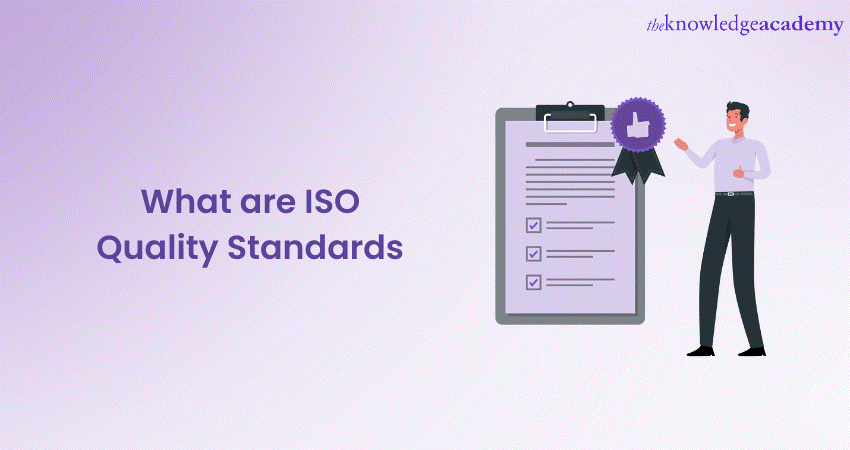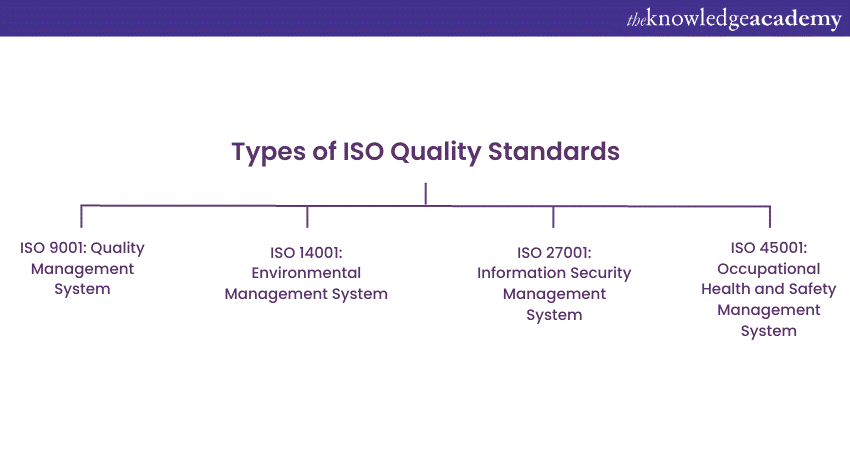We may not have the course you’re looking for. If you enquire or give us a call on +44 1344 203 999 and speak to our training experts, we may still be able to help with your training requirements.
Training Outcomes Within Your Budget!
We ensure quality, budget-alignment, and timely delivery by our expert instructors.

In today's competitive business landscape, organisations strive to deliver products and services of the highest quality while meeting regulatory requirements and ensuring customer satisfac-tion. ISO Quality Standards provide a framework that helps organisations achieve these goals by establishing effective management systems. Read this blog and learn about ISO Quality Stand-ards, their different types, benefits and challenges, and tips on how to implement them.
Table of Contents
1) An introduction to ISO Quality Standards
2) Types of ISO Quality Standards
3) Benefits of implementing ISO Quality Standards
4) Process of implementing ISO Quality Standards
5) Challenges in implementing ISO Quality Standards
6) Tips for successful implementation of ISO Quality Standards
7) Conclusion
An introduction to ISO Quality Standards
International Organization for Standardization (ISO), an independent, non-governmental inter-national organisation, develops and publishes standards for Quality Management. ISO Quality Standards are a collection of guidelines and criteria that define best practices for various as-pects of organisational management.
ISO Quality Standards play a vital role in ensuring consistency, reliability, and continuous im-provement within organisations. These standards provide a common language and framework for businesses worldwide, facilitating international trade and fostering trust between organisa-tions and stakeholders.
Types of ISO Quality Standards
ISO Quality Standards encompass a range of areas that organisations can focus on to enhance their management systems. Here, we will delve into the four primary types of ISO Quality Standards: Quality Management, Environmental Sustainability, Information Security, and Occu-pational Health and Safety. Here are some of the most widely recognised ISO Quality Stand-ards:

ISO 9001: Quality Management System
ISO 9001 is the cornerstone of ISO Quality Standards and focuses on Quality Management Sys-tems. It provides organisations with guidelines to establish robust processes to deliver high-quality products and services consistently. By adopting ISO 9001, organizations can enhance customer satisfaction, improve operational efficiency, and drive continuous improvement in line with ISO 9001 principles.
The standard focuses on customers, leadership, people engagement, a process approach, evi-dence-based decision-making, relationship management, and continual improvement. ISO 9001 Certification demonstrates an organisation's commitment to meeting customer needs and ex-ceeding expectations, bolstering its reputation and competitiveness in the marketplace, also helps to improve operational efficiency and customer satisfaction as a Benefit of ISO 9001.
To make sure that the quality management system satisfies the standards and is effective, an ISO 9001 Internal Audit is necessary. Frequent audits ensure that the company is consistently in compliance with ISO 9001 standards by pointing out areas that need improvement, aligning with the Principles of ISO 9001.
ISO 14001: Environmental Management System
ISO 14001 focuses on Environmental Management Systems and helps organisations identify and control their environmental impact. It provides a framework for setting environmental objec-tives, implementing sustainable practices, and complying with environmental regulations.
By implementing ISO 14001, organisations can identify, control, and mitigate the environmen-tal aspects and risks associated with their activities, products, and services. This standard guides organisations in setting environmental objectives, implementing sustainable practices and complying with applicable environmental regulations. ISO 14001 Certification demonstrates an organisation's dedication to environmental responsibility and sustainability, helping build stake-holder trust and attract environmentally conscious customers.
ISO 27001: Information Security Management System
ISO 27001 sets the standard for Information Security Management Systems. It assists organisa-tions in identifying and managing Information Security risks, implementing controls to protect sensitive information, and ensuring data confidentiality, integrity, and availability. In today's interconnected digital landscape, organisations face increasing risks related to Information Se-curity breaches.
ISO 27001 provides a framework for organisations to establish, implement, maintain, and con-tinually improve an Information Security Management System. By adopting ISO 27001, organi-sations can identify and manage Information Security risks, implement necessary controls to protect sensitive information, and ensure data confidentiality, integrity, and availability. ISO 27001 Certification demonstrates an organisation's commitment to safeguarding information assets, enhancing customer trust, and complying with data protection regulations.
Want to become a certified Lead Auditor and drive continuous organisational improvement? Sign up for our ISO 9001 Lead Auditor Course now!
ISO 45001: Occupational Health and Safety Management System
ISO 45001 is designed to help organisations establish effective Occupational Health and Safety Management Systems. It provides a framework for identifying and controlling workplace haz-ards, promoting worker safety and well-being, and complying with legal requirements related to occupational health and safety.
By implementing ISO 45001, organisations can establish hazard identification, risk assessment, and risk mitigation processes. This standard emphasises employee participation, training, and continuous improvement in occupational health and safety practices. ISO 45001 Certification demonstrates an organisation's commitment to providing a safe and healthy workplace, reduc-ing accidents and injuries, and complying with relevant health and safety regulations.
These four types of ISO Quality Standards cover crucial aspects of organisational management, allowing organisations to build robust systems that prioritise quality, environmental sustainabil-ity, Information Security, and occupational health and safety. By adopting and implementing these standards, organisations can enhance their operations, gain a competitive edge, and meet the expectations of customers, stakeholders, and regulatory bodies.
ISO 22000 Food Safety
ISO 22000:2018 is designed for organisations involved in any aspect of the food supply chain. It is rooted in the principles of the Hazard Analysis and Critical Control Point System (HACCP), in-cluding a framework for managing food safety risks. It also integrates the use of prerequisite programs to ensure a safe food supply.
This ISO Quality Standard overlooks the direct treatment of corrective and preventive actions, as these aspects are naturally addressed through the implementation of HACCP and prerequi-site programs within the food industry. Additionally, ISO 22000:2018 does not highlight product design and realisation. However, ISO 9001 and 22000 illustrating the difference of ISO 9000 vs 9001.
ISO 13485 Medical Device
The ISO 13485:2016 Standard, like its counterparts, draws from the ISO 9001:2015 Quality Standard (and also includes elements from the former ISO 13488). While both ISO 9001 and ISO 13485 have their own merits, they have different priorities. ISO 9001 highlights continuous im-provement and customer satisfaction, while ISO 13485 prioritises regulatory compliance and device safety. While device safety is a crucial factor in ensuring customer satisfaction, this per-spective may not align with everyone's definition of ISO Quality Standards.
Take the first step towards becoming an Internal Auditor and enhance your career with our comprehensive ISO 9001 Internal Auditor Course!
Benefits of implementing ISO Quality Standards
Implementing ISO Quality Standards can yield numerous benefits for organisations. Here are some of the key advantages:
1) Improved efficiency and productivity: ISO Quality Standards emphasise the importance of efficient processes, streamlined workflows, and continuous improvement. By implementing these standards, organisations can optimise their operations, reduce waste, and enhance over-all efficiency and productivity.
2) Enhanced customer satisfaction: ISO Quality Standards prioritise customer focus and satis-faction. By meeting customer expectations consistently and delivering high-quality products and services, organisations can enhance customer loyalty, build trust, and gain a competitive edge in the market.
3) Compliance with legal and regulatory requirements: ISO Quality Standards incorporate legal and regulatory requirements relevant to specific management areas. By implementing these standards, organisations can ensure compliance with applicable laws, regulations, and industry best practices, mitigating legal and reputational risks.
4) Competitive advantage in the market: ISO Certification demonstrates an organisation's commitment to quality, sustainability, Information Security, or occupational health and safety. This certification can differentiate the organisation from its competitors, enhance its reputa-tion, and open doors to new business opportunities.
Process of implementing ISO Quality Standards
Implementing ISO Quality Standards requires a systematic approach and the entire organisa-tion's commitment. Here are the key steps involved in the implementation process:
1) Gap analysis: Before embarking on the ISO implementation journey, organisations conduct a gap analysis to assess their current practices and identify areas where they need to align with the standard's requirements.
2) Documentation and procedures: Organisations need to develop documented procedures and policies that align with the ISO Quality Standards they are implementing in accordance with ISO 9001 Documentation.
3) Training and awareness: To ensure successful implementation, organisations must provide training and raise awareness among employees about the ISO requirements, their roles in the implementation process, and the benefits of adhering to the standard.
4) Internal auditing: Internal audits are conducted to assess the organisation's compliance with the ISO requirements and identify areas for improvement. These audits help in rectifying any non-conformities before the external certification audit.
5) Certification audit: Once the organisation has implemented the ISO Quality Standards and is confident in its compliance, an external certification body conducts an audit utilising the ISO 9001 audit checklist to verify adherence to the standard's requirements. Upon successful completion, the organisation receives ISO Cer-tification.
Take the first step towards achieving excellence with our ISO 9001 Course – sign up now!
Challenges in implementing ISO Quality Standards
Implementing ISO Quality Standards can present some challenges for organisations. It's essen-tial to be aware of these challenges and address them effectively. Here are some common challenges:
1) Resistance to change: Implementing ISO Quality Standards often requires organisational processes, culture, and mindset changes. Resistance to change from employees or stakeholders can hinder the implementation process. Effective change management strategies and commu-nication can help overcome this challenge.
2) Resource constraints: Implementing ISO Quality Standards may require allocating re-sources, such as time, budget, and personnel, which can strain the organisation's capabilities, particularly for smaller businesses. Careful planning and resource allocation are crucial to ad-dress this challenge effectively.
3) Maintaining compliance: ISO Certification is not a one-time achievement; organisations must maintain compliance continuously. This requires ongoing monitoring, internal audits, and periodic reviews to ensure the management system remains effective and aligned with the ISO requirements.
Tips for successful implementation of ISO Quality Standards
To maximise the benefits of implementing ISO Quality Standards, organisations can follow these tips:
1) Commitment from top management: Top management must demonstrate commitment and actively support the ISO implementation process. Their involvement creates a culture of ISO Quality Standards and drives the organisation's efforts towards successful implementation.
2) Employee engagement and training: Engaging employees at all levels and providing them with the necessary training and resources are essential for successful ISO implementation. Em-ployees should understand the benefits of adhering to the ISO requirements and be actively in-volved in the process.
3) Continuous improvement: ISO Quality Standards emphasise continuous improvement. Or-ganisations should encourage a culture of learning, innovation, and process refinement. Regu-lar evaluations, feedback loops, and data-driven decision-making can help identify areas of im-provement and drive organisational growth.
Conclusion
Overall, ISO Quality Standards provide organisations with a structured framework for achieving excellence in various management aspects. By implementing ISO Standards, organisations can improve efficiency, enhance customer satisfaction, ensure compliance, and gain a competitive advantage. While the implementation process may pose challenges, with proper planning, commitment, and ongoing improvement, organisations can reap the benefits of ISO Certifica-tion.
Want to unlock your organisation's potential? Sign up for our comprehensive ISO 9001 Training today!
Frequently Asked Questions
Upcoming Business Improvement Resources Batches & Dates
Date
 ISO 9001 Foundation course
ISO 9001 Foundation course
Mon 6th Jan 2025
Mon 3rd Mar 2025
Mon 2nd Jun 2025
Mon 4th Aug 2025
Mon 20th Oct 2025
Mon 1st Dec 2025







 Top Rated Course
Top Rated Course



 If you wish to make any changes to your course, please
If you wish to make any changes to your course, please


